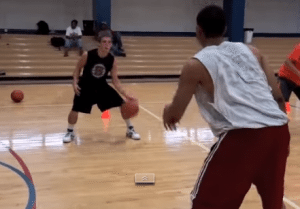 Finding the balance between the amount of time we allocate to individual player development versus the time we allocate to actually getting our teams ready to play is no simple task.
Finding the balance between the amount of time we allocate to individual player development versus the time we allocate to actually getting our teams ready to play is no simple task.
As usual, there is a spectrum and at one end you have the coach who just works on team and game preparation and pretty much ignores player development. It’s possible that this coach is pressed for time but the general attitude is, “Players aren’t going to get much better anyway and teams can improve a lot by playing together a lot.”
Usually on this particular issue, there aren’t diametrically opposite coaches who work on player improvement exclusively and ignore 5 on 5 play. But, there are many instances where coaches do a lot of individual drill work at the expense of relating those drills to real basketball.
Most coaches will land somewhere in the middle of this argument on the premises that better components (players) can make for a better whole and that games force us to concentrate on team play. The best programs, however, will have comprehensive skill development side (shooting, passing, handling, sliding etc.) and physical development side (strength, speed, quickness, agility, etc.).
Again, the real irony in this regard is that the higher the level of play, generally the more time that is spent on individuals. Of course, there are good reasons for that. Professional players are compensated and in theory are on call to practice at any time and any way management deems appropriate. At the college level, even though there are NCAA practice restrictions, players are on scholarship and are expected to be quasi-employees.
At high school and lower levels, it’s obviously not quite as simple. As true “amateurs” in most cases, players at these levels are restricted by state associations’ start dates and dead periods, playing multiple sports, parental influences and many other outside distractions and interests.
Whatever the case, there are measures coaches can take to increase the amount of time they spend on their player development. Whether a coach has a generic list of skills and drills for all of his players or he devises a unique list for each player (the player could actually participate in this process), player and coach should be on the same expectation page. Once this list is devised, coaches can decide which options can best suit their situations to build creative workout opportunities.
A short list of a few possibilities follows:
PRE-SEASON: Once regular season practice starts, how much time will you allocate to individual development? Usually coaches can devote a higher percentage of their regular practice time during this 3 to 4 week period before games start.
IN-SEASON: Another decision. Most coaches will still devote some regular practice time to development but will be creative in finding other time slots.
PRE-PRACTICE: If there is a space and time slot available, 15-20 minutes even three times a week can be very beneficial.
STUDY HALLS, EXTENDED LUNCH HOURS: Every school schedule is different, even day-to-day. Time slots can be available if one is looking.
DOUBLE SESSIONS: Pre-season, vacations, half-days can present opportunities. One practice can be “team” oriented, the other can be shorter and be individual oriented or even in-bounds plays oriented.
OFF-SEASON: Some states allow for 3 players to be coached or other variations. This can also be a great time to get to better know new players.
Last, once you’re comfortable with the quality of your drills, the workouts can be monitored by assistant coaches, managers or even self-monitored. Time, space and personnel issues can always be overcome by thinking outside the box and utilizing all the assets one has at his disposal.
How much time do you spend on individual development? How do you get it done?



The game is about Jimmy’s and joes not X’s and O’s Out of season 90% individual. In season 60 % individual. Out of season all individual offensive and defensive skills and basic transition and motion offense. Out of season games I tell kids to be selfish offensively and defense is man for man with some help side rules. In season i run ten minute segments of man,zone,transition,press break, and delay.
Great quote Rick. I think I will add it to the quotes page – Jimmy’s and Joes not X’s and O’s!